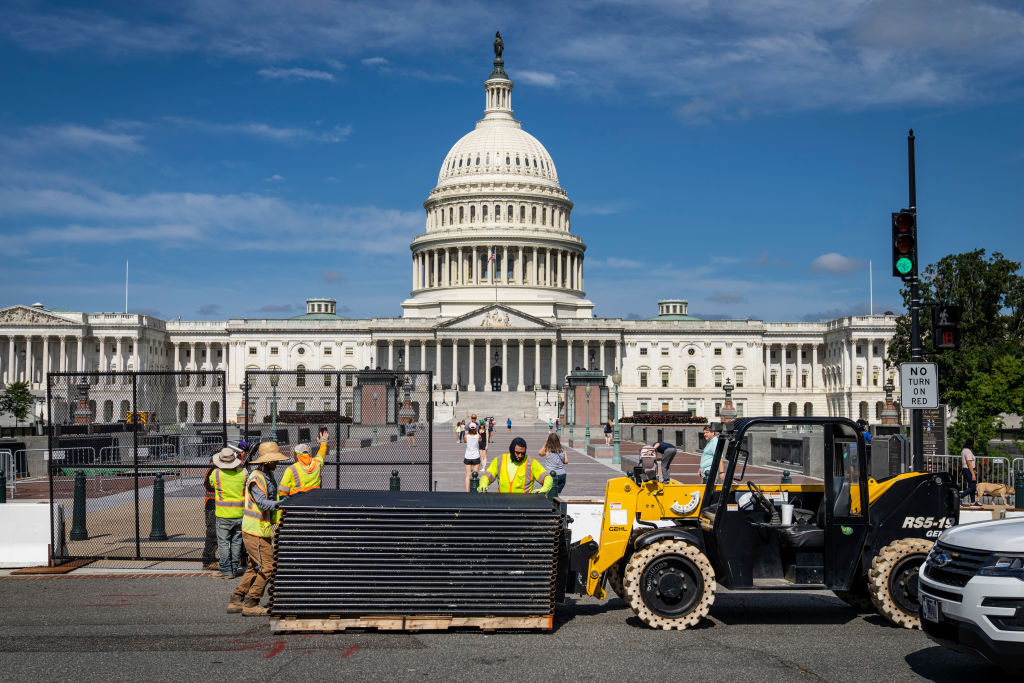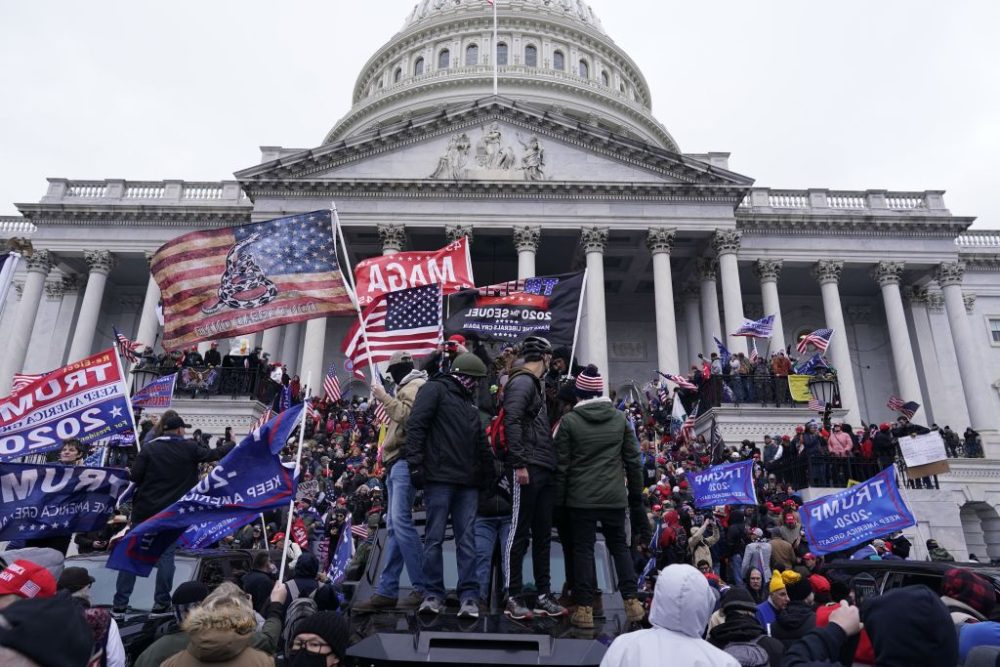Following the Capitol Hill riot of January 6, a fair number of elected leaders — mostly Democrats — and law enforcement officials expressed their belief that an armed insurrection was in the works. Hostile forces were said to ready to attack Washington intent on overthrowing the government. To forestall this, fences topped with razor wire were installed and members of the National Guard were kept on active duty. March 4 was rumored to be the date set for this uprising.
No army of insurrectionists appeared on March 4 or any other date. Nor as far as anyone can tell was there ever a prospect for such an attack. On March 1, the razor wire was removed from one of the tall fences, but reinstalled on a shorter fence across the street, closer to the Capitol. The 2,149 National Guard troops were sent home in late May, their deployment ending officially on May 23. Between July 9 and 11, the remaining fences were removed. Yet still security at the Capitol remains tight. How much of this is prudence — and how much it for show? And if for show, how long will the show go on? Can we have an intermission?
Elaborate preparations for something that never happened and, in all likelihood, was never planned in the first place are all in a day’s (or a half a year’s) work for the US military. But it remains an interesting question of just who set in motion the preposterous idea that the danger was real. Some observers point to the bizarre cult QAnon, which has a history of announcing imaginary plots. I suspect QAnon consists of a dozen FBI agents who spend their days trolling for gullible folks who spend their days trading internet gossip. An army of revolutionary warriors QAnon is not. It’s now been alleged that some other supposedly subversive groups such as the Proud Boys and the Oath Keepers, along with the 14 men indicted for plotting to kidnap Michigan governor Gretchen Whitmer, were organized and led by FBI agents and informants.
But it served some political leaders to pretend that the March 4 ‘storm’ that the QAnon-omists had prognosticated was an actual threat. Hyping the fantasy of the lunatic fringe that itself was probably the conjuring of overly zealous law enforcement officials seems like a strange way to advance the nation’s business. Of course, the fences, razor wire and troops might well have been intended for a purpose other than staving off the Army of the Living Deplorables.
They could have been there, for example, to sustain the panic that many members of Congress voiced immediately after the January 6 riot. Democrats especially were eager to evoke a national emergency based on the idea that Donald Trump’s bloodthirsty supporters would be back, the next time equipped with something more than outlandish costumes and hand-lettered signs. Declared emergencies are good ways to consolidate power, especially if popular support is feeling anemic.
All of this is familiar territory to anyone with the slightest interest in the nation’s political theater. The Democrats evoked the tenuously attested QAnon conspiracy to advance a conspiracy of their own, aimed at faking out their supporters and the media about the dangers that lie ahead. Either that, or the QAnon hordes beat a hasty retreat in light of the superior tactical wisdom of Nancy Pelosi. Take your pick.
The Phantom Razor Wire Rebellion, to give it a name, is a fine example of the murkiness of conspiracy accusations. I have been writing a bit about so-called ‘conspiracism’ recently. (See, for example, ‘We conspiracists, we happy few’ in these pages). One source led me to another and I just finished a book published in 2019 co-authored by Dartmouth and Harvard professors. A Lot of People Are Saying: The New Conspiracism and the Assault on Democracy by Russell Muirhead and Nancy L. Rosenblum hasn’t aged very well during its two years in print. Muirhead and Rosenblum direct withering scorn at people who entertain ideas such as the claim that the FBI spied on Trump’s 2016 campaign (Indeed it did. The FBI called it Crossfire Hurricane.) They laud Robert Mueller’s investigation of ‘a massive conspiracy to breach national security and subvert American elections’. (Oops.) They deride the idea that Democrats might engage in electoral mischief in order to gain power. In other words, what Muirhead and Rosenblum, who style themselves as champions of strict evidence-based theories, haul forth as evidence of ‘conspiracism’ on the part of Trump supporters has, in a few short years, proven to be worthless speculation. Their facts turned out to be ‘facts’, those graceless scarecrows of wishful thinking that dot the information superhighway.
Let me say immediately that I enjoyed A Lot of People Are Saying in a mordant, schadenfreude spirit. Hardly a page goes by without a stern declaration or two of steely truth-telling that now offers belly- laughs of appreciation. Muirhead and Rosenblum give us a finger-wagging lecture concerning the conspiracists who unfairly depict ‘the mainstream press and the scientific community skewed by political bias’. (Global warming, anyone? COVID masking?) They lament the fading authority of ‘producers, editors and scholars who decided what was worthy of dissemination’, but who are now outflanked by people who write and publish on the internet without such oversight. The people who suppressed the story of Hunter Biden’s laptop will never, as long as they live, regain the public’s trust in the media. Would Fauci’s troublesome relationship with the truth be known without these outlaw observers? Or would we still be adhering to the ‘Wuhan Wet Market Bat Soup’ Theory?
I don’t want to be too harsh on Muirhead and Rosenblum. Well, actually I do. I find them insufferable academic snobs in love with their own ersatz authority and wholly dependent on progressive talking points. But it is best that I suppress that urge. Any of us who write articles or books is in danger of being overtaken by events. Think of how embarrassed I will be if next week the QAnon Army sweeps through Washington DC and installs Marjorie Taylor Greene as president for life. It would be awkward. But not quite as awkward as having written A Lot of People Are Saying.
Conspiracism, in the Muirhead and Rosenblum world, refers to conspiracy theories ‘without the theory’. Conspiracists skip over the logical links and just trade in rumors and assertions, endlessly repeated and widely circulated, without ever citing evidence or so much as ‘connecting the dots’. Good conspiracy theories in their view are at least thought through, perhaps obsessively. But we now live, M & R say, in the age of junk conspiracy theories, where the mere adjective ‘fake’ is sufficient to undermine confidence in hard-won facts. Conspiracism undermines scientific, journalistic and academic authority, and thus ‘delegitimates democracy’.
If this picture belonged solely to Muirhead and Rosenblum, I’d leave it to sink with the rest of their top-heavy enterprise, but it represents a view I’ve heard often enough that I think it deserves a reply. Pithy phrases such as ‘fake news’ are not, of course, fine-meshed arguments or propositions backed by sifted evidence. But that doesn’t mean they float around like helium balloons in the breeze. They invite the listener to stop and consider whether the smooth-talking journalist is sneaking suppositions into his questions, or whether his assertions have been cleverly arranged to give misleading impressions. Splicing together two different remarks by Trump to make it appear that he was calling neo-Nazis in Charlottesville ‘very fine people’ is perfect example of such ‘fake news’. Leaving it to others to discover the fakery in jazzed-up CNN or NPR stories is excellent rhetorical technique, not a failure to provide argument and evidence.
Accusations such as ‘fake news’ condense complicated matters to their bare essence. I spent some 200 pages in 1620, providing a detailed, evidence-based, and argued refutation of the New York Times’s 1619 Project. If someone merely labeled the 1619 Project ‘fake history’, he would not have been wrong — and he would not have been engaged in conspiracism. Instead he would have provided an apt phrase that might well put people on the right track. Read my book, or one of the several others that now offer detailed refutations of the 1619 Project, if you want to command the detail. But the term ‘fake history’ won’t mislead you. Nor will the term ‘fake news’ applied in the contexts in which Trump typically deployed it.
Conspiracy at bottom is about plots, those human endeavors to outwit or outplay rivals. Some conspiracies are just imagined but others are plenty real. The plot to kill Lincoln was a conspiracy in which John Wilkes Booth was joined by Lewis Powell, David Herold, John Surratt, George Atzerodt and Mary Surratt. John Surratt escaped to Europe, but the others were hanged. Recognizing that people often hide their motives as well as their actual plans is just the stuff of ordinary life. Or sometimes extraordinary life. What are we to make of the Pentagon’s sudden admission that UFOs are real, after decades of Pentagon denials? Conspiracy seems the right word here too, although ‘unresolved mystery’ might be a fraction more reassuring. We don’t like being left in the dark.
At least not for too long. The conspiracy that resolves itself by the end of the book or the play is entertaining and can go being so as long as no one spoils the suspense. Agatha Christie’s play The Mousetrap ran in London’s West End Theatre continuously from 1952 until it was shut down by the COVID restrictions in March 2020. It was always accompanied by a plea to the audience not to tell others about the deceptions the killer employed. Most people kept the secret.
Perhaps that is what today’s manipulators of elections and public opinion are counting on. One of the best ways of conducting a conspiracy has always been to lay breadcrumbs to others. That’s how the master conspirator Iago tricks Othello into murdering Desdemona. Today, if our republic is really at risk, it is not the disorganized and demoralized supporters of the old regime who are to be feared. It is the people who executed the head-fake on a Capitol Hill insurrection. What they are really about is a mystery — one that is not quite so baffling as UFOs, nor so tame as an Agatha Christie who-done-it. The conspiracy to watch out for is the one in which the actors declare that they will protect us, provided that we trust them. After what we have seen these last few years, we’d be fools to do so.

























